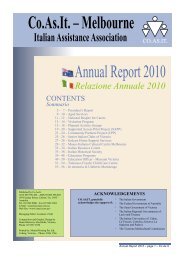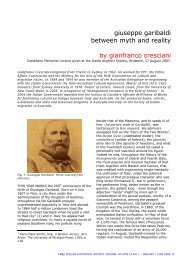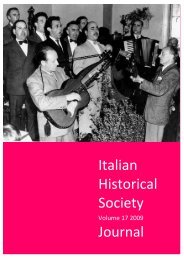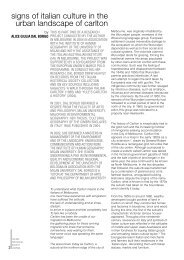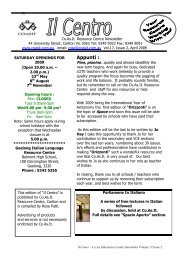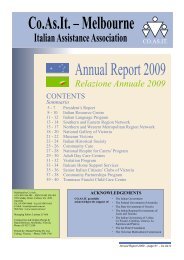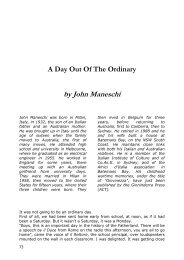January-December 2010, vol. 1
January-December 2010, vol. 1
January-December 2010, vol. 1
- No tags were found...
You also want an ePaper? Increase the reach of your titles
YUMPU automatically turns print PDFs into web optimized ePapers that Google loves.
... On two walls of the building the name Matteotti Club waspainted in large characters and, defiantly, a red flag flutteredfrom its pole” 1 . The joyous chaos of the Victoria St. Club borethe closest resemblance to home, even though it served VB inplace of Birra Moretti.‘Little Italy’ grew up that day. The din of lilting language andmusic was silenced as they were marched into a truck andsearched, one by one. Nonno’s passport and papers weretaken; his physical freedom officially forsaken. The photo of hisparents was tossed away in a hessian sack.Fig 2. Clemente (second from left) and his friends sunbaking on Lipari,the small Mediterranean island off the north coast of Sicily, c.1930.Image courtesy of the Cerreto family.This often-traced photo had been his prized portal to the past,already creased and fading; the original image was irrevocablygrainy. Like all aboard the Viminale, Nonno told the story ofclinging to the hope of recreating that sense of place in the NewWorld. They floated adrift in no-man’s-land singing to thecloaked sky while the stowaway sun travelled aboard inphotographs, suitcases, music and memory.A new document reads: 27 May, 1943. Unsworn evidence.Internee CERRETO: “I am not a fascist. I have never been afascist.”Fig 4. Clemente (left) and brother Luigi at the beach in Lipari. Imagecourtesy of the Cerreto family.Through grainy sepia, Nonno and fellow inmates of the campMusic Club look gaunt but happy. Nonno and his paesanicreated an oasis of Italy in the South Australian desert. Thenemici stranieri with black eyes and olive skin lived amongstfriends, able to connect through shared experiences. Nonnotold us these stories with a sense of acceptance. He understoodthe Australian reaction to his alien status; they sought safety likeeveryone else. Yet, this was little comfort as the red dirt thatinfiltrated everything also turned the colour of his once-pressedsuit from cream to burnt porridge. He felt exactly like the ‘dirtydago’ that gli Australiani told him he was.Fig 3. Excerpt of statement of unsworn evidence by Clemente Cerreto,27 May 1943. Image courtesy of National Archives of Australia.While the stories he told me had a larger-than-life, rehearsedfeeling to them, this evidence, given to a Lt. Col. Chambers, wasdesperate and real. The idea of my fence-singing Nonno as afascist was far from anything I knew about him.”Salute!” they would cheer (on the second or third glass ofrough Sicilian wine). Cards and music played, stories shared in aflowing common tongue. In those days the Matteotti (anti-Fascist) Club was the meeting point for Italians, which “on 1<strong>December</strong> 1928 ... reopened officially in the much largerpremises at Victoria Street, Melbourne. The new Club,conveniently situated near the Trades Hall, included severalrooms, a large hall, capable of holding one thousand people,and a spacious courtyard, where the members could play bocceNonno’s escape was one of those family stories we’d all heardabout. It was 12 September 1945. The camps were low security,no solitary confinement or great escape tunnels; but still, hisescape was pretty gutsy. De-strung, the mandolin’s rosettesound hole was perfect for concealing food. Its belly filled withdried meat and stale bread, the eight strings were refastened.I imagine Nonno standing, dusting away the layers of red dirt.From afar, the camp looked like a haven for travellers, butinternment after Italy signed the armistice with the Allies inSeptember ’43 too much to bear. The neglected southern fencewas his ticket out. Another internee had recently been shotwhile trying to escape. Nonno ran into a desert thatunforgivingly left desperate men exposed. Freedom was won asthe train departed for Adelaide. For now, the alien was safe.1 http://www.takver.com/history/italian.htm#fn20IHSJ ITALIAN HISTORICAL SOCIETY JOURNAL VOLUME 18 <strong>2010</strong> | 41





